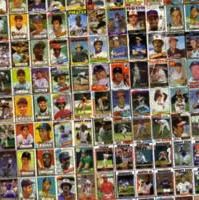
A lot has changed since the late 1980s/early 1990s. Children today seem more content with playing online games than opening a pack of the latest popular card. So when did everything change? The baseball card industry was at its peak in the early 1990s. New stars such as Ken Griffey Jr. and Barry Bonds, and new companies in the industry led to more exposure and, with that, a bigger footprint. It is hard to find a guy who grew up in this time who did not collect baseball cards. Even my friends who had no athletic talent would collect so they could trade with the rest of us at lunch or after school. Trading a Cal Ripken for an Ozzie Smith card happened on a daily basis between my friends. I loved to trade my Mets cards, and my best friend loved to collect late 1980s Mets so it was a perfect combination. In the early/mid 1990s, the Rockies and Marlins joined the league and instantly became my new fix. Collecting them was a task that I would stop at nothing until I completed it.
It is safe to say I was a baseball card addict. My childhood bedroom looked like a shrine to the modern baseball greats. I don’t even know how I found the time to sort through all of the cards I owned, but when I recently opened one of the boxes I had saved at my parents’ house, I found a set of cards broken down by team and then each card was placed in the sleeve alphabetically (damn I was a baseball card nerd). This all seemed normal to me back then. This was before I had a driver’s license and way before I could drink alcohol, so what else was I suppose to do for a hobby?
The Major League Baseball strike of 1994 came at the worst possible time for the baseball card industry. Not only were there many new companies starting up, but basketball, football and hockey had followed baseball, and new sports card shows were popping up at most local shopping malls on a regular basis. Not only was getting the newest cards exciting, but collecting older/vintage cards had become a hobby for older baseball fans. However, the lifeline of the industry still was the youth of America.
Since what children deem as popular changes on a regular basis, it is easy to see why the industry could be forgotten during the 1994 strike. Attention was turned to other collectibles. Action figures such as Starting Lineups and McFarlands became a hit. People saw having a figure to display as a better way to show off their collectibles. All of a sudden, flipping pages in a binder to show off your best baseball cards was no longer considered cool.
Another reason for the industry falling off was collectors mistakenly looked at purchasing cards as an investment. Obviously over the years, the value of baseball cards has diminished and, with that, most baseball card collections have the same value as the lint in somebody’s pocket. Those who got into the industry thinking they were going to be able to live off what they make by selling their cards had a rude awakening. The outrageous prices being asked for cards would never be equaled, and there was not much profit to be made in the long run. This was the Tyson haymaker to the baseball card industry. What was made for fun had now become a business, and a failing business at that.
In all honesty, the instant uppercut dealt to the baseball card industry in the late 1990s by the overpopulation of the market still is felt today. Sure, Topps and a few other brands are still around, but the industry is not what it used to be by any means. You may still find a handful of kids who thoroughly enjoy opening up a pack of cards and seeing what players they can add to their collection, but a majority of today’s youth would rather build a team on a video game than collect the team’s baseball card set.
I still have my Ken Griffey Jr., Cal Ripken and Barry Bonds cards. I never looked at my baseball cards as an investment. I looked at them as a hobby. I plan to pass them on to my children one day. I still enjoy reading the stats on the back of cards and looking through the set for the best action picture on the front. I am still, deep down, a baseball card junkie. The problem is, in the future, I may not be able to get my fix.
